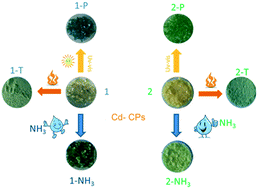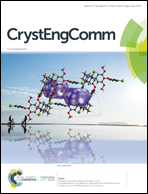Two novel multichromic coordination polymers based on a new flexible viologen ligand exhibiting photocontrolled luminescence properties and sensitive detection for ammonia†
Abstract
A new flexible bipyridinium ligand, 1,1′-bis-((3-carboxylatobenzyl)-4,4′-bipyridinium) dichloride (H2bcbpy·2Cl), was synthesized and successfully introduced into two novel cadmium-based coordination polymers (CPs) by analogous solvothermal reactions. Because of the presence of electron-deficient bipyridinium moieties, compounds 1 and 2 can both easily undergo photo- and thermal-induced electron transfer and exhibit eye-detectable photochromic and thermochromic behaviors. Moreover, their luminescence properties can be switched by UV-vis light irradiation or by heating to 90 °C. Interestingly, 1 and 2 have a sensitive response for ammonia. The yellow compounds 1 and 2 turn blue and green, respectively, when exposed to ammonia vapor. For most CPs-based bipyridinium derivatives, their crystal structures are usually damaged when exposed to ammonia vapor. Surprisingly, compound 2 displays a fast discolored–decolored response to ammonia within dozens of seconds and maintains an unchanged crystal structure.

- This article is part of the themed collection: Editor’s collection: Chromism in Frameworks


 Please wait while we load your content...
Please wait while we load your content...